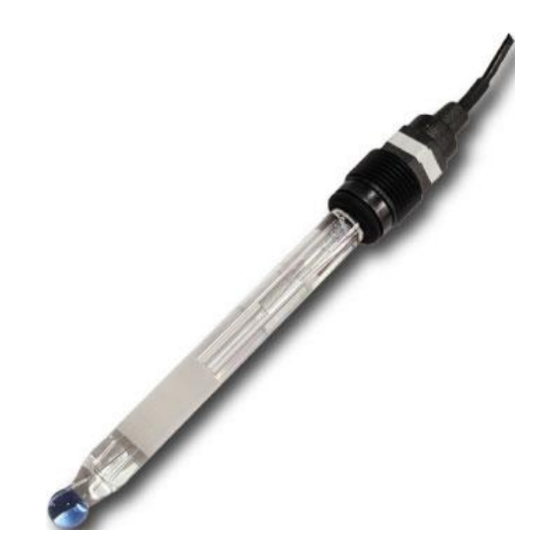
Table of Contents
Advertisement
Quick Links
Advertisement
Table of Contents

Summary of Contents for Senect XT1
- Page 1 ORP Sensor XT1 MANUAL...
-
Page 2: Type
Please read this manual carefully and store it so that you can use it later. Read the warning and safety notes attentive. Further information and latest software releases or documents can be downloaded from: www.senect.de © SENECT GmbH & Co. KG - FW01.10... -
Page 3: Table Of Contents
Table of contents Table of contents Type ....................2 Table of contents ................3 Used symbols and wording ............4 General Security Notes ..............5 Intended use .................. 6 Getting started ................7 Scope of delivery ............... 7 Installation and start-up ............7 Maintenance and cleaning ............ -
Page 4: Used Symbols And Wording
Used symbols and wording Used symbols and wording DANGER! Warning of life threatening dangers. WARNING! Warning of possible life threatening and / or severe irreversible injuries. ATTENTION! Warning of possible medium or slight injury. ATTENTION! Follow the notes to avoid damage of equipment. -
Page 5: General Security Notes
General Security Notes General Security Notes The ORP Sensor XT1 is an electronic sensor unit for the measurement of the oxidation-reduction potential (ORP or short redox-potential) of water and must be used in combination with SENECT control units. Since it is an electronic product the common prerequisites for a safe instrument usage must be fulfilled. -
Page 6: Intended Use
0°C and +40°C. It is not allowed to modify the sensor, to open the housing or to insert anything into the housing. The ORP Sensor XT1 is designed to be operated by professional users. However, it can be operated by children... -
Page 7: Getting Started
Getting started sensor is from -1000 mV up to +1000 mV and the resolution of the sensor signal is 1 mV. The ORP Sensor XT1 must be used in combination with SENECT control units. The sensor is designed for the use in industrial aquaculture applications. - Page 8 Getting started Choose a place for the electronic interface of the XT1 which is clean, dry and protected from direct sunlight. Ensure that all cables are placed safely and all regulations are fulfilled. 1. Connect the cable of the electrode with the electronic sensor interface (BNC-plug).
-
Page 9: Maintenance And Cleaning
Maintenance and cleaning For the mounting of the electrode, flow through measurements cells can be used. If the electrode shall be placed at an open water surface, it can be mounted on a buoy e.g. made of Styrofoam. Please consider here, that the electrode must be in a place with low to moderate currents to deliver correct measurement results. -
Page 10: Cleaning
Maintenance and cleaning Cleaning The active glass part of the electrode must not be cleaned with abrasive or aggressive cleaning agents (e.g. scouring milk). Scratches on the glass part can damage the electrode. However, dirt on the glass must be removed. Use therefore a water-dipped soft paper towel and rinse the electrode with clean water. -
Page 11: Lifetime
Avoid the contact to inorganic cleaning agents like acetone or chloroform. This may damage the membrane. Steam disinfection can also damage the sensor. Depending on the used firmware of your control unit, the menu can change. Please refer therefore to the current manual which found www.senect.de. -
Page 12: Calibration
Maintenance and cleaning Calibration 1. Unplug the electrode and plug in the BNC calibration plug. Select in the menu „Sensor calibration / ORP / Calibration Point 1“ and press OK or wait 120 s. 2. Remove the calibration plug and plug in the ORP electrode. - Page 13 Maintenance and cleaning 4. Select in the menu of your control unit the ORP sensor (Sensors / Sx: ORP) and select “Sensor Calibration / ORP / Calibration Point 2“. 5. Select the ORP value of your calibration solution (here: +475 mV) and stir the electrode gently until the displayed raw signal value (in digits) is nearly constant.
- Page 14 6. If the calibration worked select „Save calibration“. 7. Rinse the electrode with tab water again. Your SENECT ORP Sensor XT1 is not ready to be used. Fig. 1: Calibration curve with two calibration point. Tipp: It is also possible to load old calibrations. There you can also see the calibration coefficients.
-
Page 15: Notes Regarding The Measurement Of The Oxidation-Reduction Potenteial
Notes regarding the measurement of the oxidation-reduction potenteial Every delivered SENECT ORP Sensor is inspected by our quality check with respect to perfect functioning and calibration. Despite the high quality standards, interferences of the sensor signal based on the measurement principle and properties of the medium can occur. - Page 16 Notes regarding the measurement of the oxidation-reduction potenteial The measurement of the oxidation-reduction potential is determined by the concentration of substances, which act as oxidating or reducing agents. In some cases, the concentration of these substances is too low to achieve reliable results.
-
Page 17: Technical Data
Technical Data Technical Data Dimensions Electrode: Ø 12 mm, Length: 120 mm Cable length: 5 m + 2 m Supply voltage: 24 V DC Power consumption: << 1 W Temperature range: 0° to 40 °C Max. Pressure: 6 bar Range: -1000 mV to +1000 mV Precision: <... -
Page 18: Information About The Correct Disposal
Information about the correct disposal... -
Page 19: Guarantee
Alternatively, you can also send the product back to the producer. The SENECT GmbH & Co. KG is member of the Stiftung Elektro-Altgeräte Register and the products are registered (WEEE-Reg.-Nr.: DE37193510).



Need help?
Do you have a question about the XT1 and is the answer not in the manual?
Questions and answers